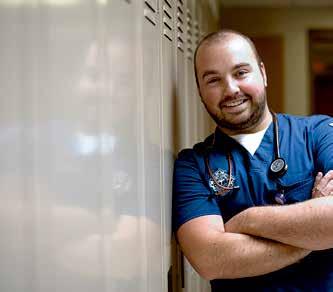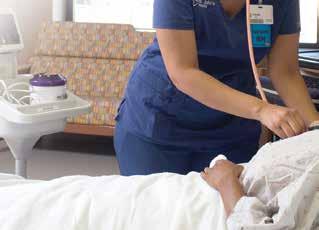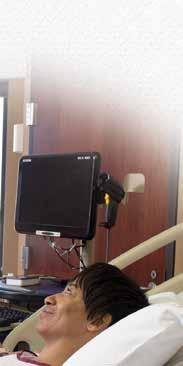
mailed to approximately 184,000 RNs in Illinois.


mailed to approximately 184,000 RNs in Illinois.
The Illinois Nurses Foundation (INF) held its annual Holiday Fundraising Gala on December 9th, 2017 at the Hilton in Lisle. It was a spectacular evening for the Foundation and all those in attendance. Multiple organizations showed their support for the Foundation with the purchase of entire tables, which provided a wonderful way to spend time with friends and family during the holiday season while supporting a great cause. Many attendees also took the opportunity to do some Holiday shopping at the Gala. Thanks to the overwhelming support of all the attendees, the Fundraising Gala was a great success in raising funds for INF.
Adding to the evening, everyone enjoyed a plated 4-course dinner and cash bar. Guests also danced the night away to today’s hit music provided by a D.J.
New this year, the Foundation launched its “Honor a Nurse” campaign. The project was designed to Honor nurses who have inspired us; who have fought for the advancement of the profession; and who deserve recognition for their commitment to their patients and the work they do every day.
Nominations for the “Honor a Nurse” campaign were received throughout the year. The outpour of touching stories received were reviewed and narrowed down to five finalists, chosen by the Foundation Board members.


The five finalists were Sharon Bartmer, RN, Dr. Joyce Keithley DNSc, RN, FAAN, Dr. Margaret Faut Callahan PhD, CRNA, FNAP, FAAN, Rhys A. Gibson, BSN, RN, and Dr. Vicki Keough, PhD, APRN-BC, FAAN. The 2017 Nurse of the Year award was then presented to Dr. Vicki Keough. The story submitted to honor Dr. Keough read:

“Dr. Vicki A. Keough is a leader and already a legend in advancing the role of the nurse practitioner in trauma, emergency, and acute care nursing. Her visionary and collaborative leadership over three decades has resulted in the creation of the role of the acute care nurse practitioner program at Loyola University Chicago’s Niehoff School of Nursing, the only program of its kind in the Midwest and the second in the nation. Ahead of her time, in 1994 she led an interdisciplinary team of physicians and nurses, before the term ‘interprofessional collaboration’ was in vogue.
Vicki is a practical woman and chaired the Emergency Nurses Association national projects to provide acute care nurses with tools to use in the ED to treat patients with alcohol disorders. The SBIRT Toolkit
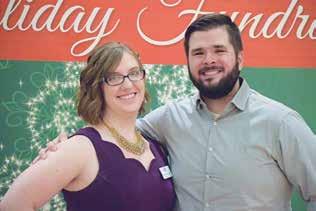
(Screening, Brief Intervention and Referral) is designed to assist nurses to screen and provide brief intervention and referral for treatment of ED patients with alcohol use disorder. The Work Injury Prevention Toolkit is another creative endeavor to prevent work-related injuries in the Emergency Department and used by nurses across the nation and internationally.
Perhaps on your bookshelf is Editor Vicki Keough’s advanced practice emergency nursing book entitled Advanced Practice Nursing: Current Practice Issues in Emergency Care. She has published 27 manuscripts (data-based and clinical articles). Because of her distinguished research and scholarly reputation, she continues to be invited to deliver regional, national and international presentations and symposiums.”
INF Holiday Gala & Fundraiser continued on page 4
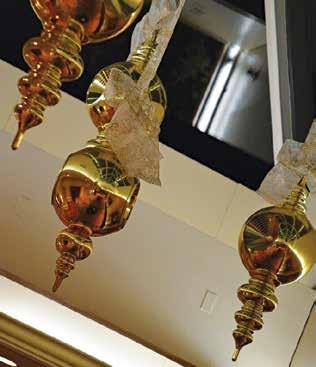
Karen J. Egenes, RN, EdD, CNE, ANA-IL Board Member at Large, IL Nurses Foundation Board Member, Associate Professor, Marcella Niehoff School of Nursing, Loyola University Chicago
Greetings from Karen Egenes. I am a member of the ANA-IL Board of Directors, serving as a Director at Large. In this capacity, I also serve as member of the Board of Directors of the Illinois Nurses Foundation (INF), as a liaison and representative from the ANA-IL Board. For the majority of my career, I have worked in community health nursing, in both clinical practice and in education of students in this specialty area.
Thus, I was interested to read a recent report that was commissioned by the C.S. Mott Foundation, a philanthropic organization based in Michigan (https:// www.mott.org/wp-content/uploads/2014/01/ thevalueofcommunityphilanthropy.pdf ). The study identified a current trend in which philanthropy is increasingly promoted by groups of ordinary persons living everyday lives, rather than by affluent and influential leaders in society. The report described this approach as philanthropy from the bottom up, rather than from the top down, as has been the more traditional style.
The European Foundation Centre has labeled this trend as “community philanthropy,” which it defines as: “…the act of individual citizens and local institutions contributing money or goods along with their time and skills, to promote the wellbeing of others and the betterment of the community in which they live and work.” (Quoted in Steven Mayer (2005) “Community philanthropy and racial equity: what progress looks like,” www.effectivecommunities. com/ pdfs/ECP_CommunityPhilanthropy.pd f). Building on this definition, the Mott Foundation study asserts an important characteristic of community philanthropy is the community members’ use of their own money and
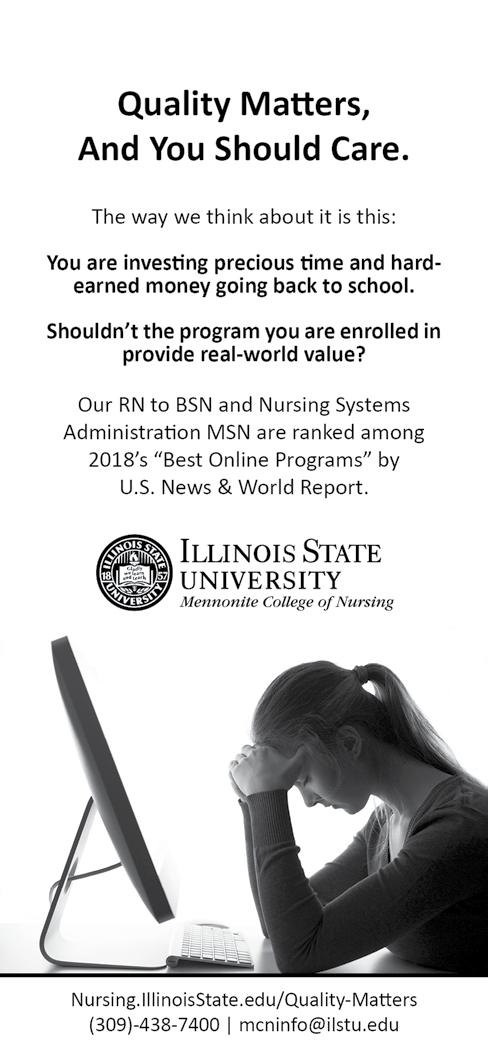
assets to build a better future for all members of the community. The study adds that this is a more hopeful approach than the more traditional track of assessing of what the community lacks and then developing a plan to remedy these deficits. A second necessary component of “community philanthropy” is the perpetuation of the values that unify members of the community, and also the assurance that the benefits of the philanthropic endeavor are spread to all members of the community.
So, what can this mean for us as members of the nursing community in IL? First, I was interested in the extent to which the work of the INF fits the description of “community philanthropy.” The INF was founded by nurses to benefit all nurses in IL through the advancement of our profession. Through the development of nursing, the ultimate goal of the Foundation is to promote the health of the citizens of our state. The majority of the contributions to INF are given by ordinary nurses. But each contribution is of great value, because it constitutes an individual nurse’s tangible support for the larger community of nurses; the fellow members of our profession.
Programs sponsored by INF, such as the nurse scholarship program and the 40 Under 40 Program, constitute ways of progressing toward our envisioned future for nursing in IL. These programs provide support and recognition for the nurses who will be the future leaders of the profession in IL. Through contributions to these programs individual nurses have a role in shaping our collective future. Thus, nurses promote the development of colleagues who will work both with them and for them.
Further, the INF programs described help to spread and preserve the basic values of nursing.
For example, an important, but less advertised INF program provides aid to nurse colleagues whose lives have been disrupted by crisis, illness, or natural disasters. Nurses can apply to the INF for financial assistance during a time of personal tragedy.
IL nursing, led by the efforts of the INF, is on the cutting edge of “community philanthropy.” The contributions of individual nurses promote the development of the profession as well as the improvement of the health and welfare of the citizens of our state. We thank you, the community of IL nurses, for your contributions to the efforts of the INF, and ask for your continued aid in the advancement of our goals for our profession and for the public that we serve.

INF Board of Directors
Officers
Maureen Shekleton, PhD, RN, DPNAP, FAAN President
Alma Labunski, PhD, MS, RN Vice President
Cathy Neuman, MSN, RN, CNAA Secretary/Treasurer
Directors
Cheryl Anema, PhD, RN
Maria Connolly, PhD, CNE, ANEF, FCCM
Karen Egenes, EdD, MSN, MA, RN
Jacqueline Garcia, MSN, APN, NP-BC
Brandon Hauer, BSN, RN
Linda Olson, PhD, RN, NEA-BC
Bonnie Salvetti, BSN, RN
Kathryn Serbin, MS, DNP, RN

2015-2017 ANA-Illinois Board of Directors
Officers
Dan Fraczkowski, MSN, RN
Ann O’Sullivan, MSN, RN, CNE, NE-BC, ANEF
Pam Brown, PhD, RN, ANEF
Kathryn Serbin, MS, DNP, RN
Directors
Karen Egenes, EdD, MSN, MA, RN
Colleen Morley, MSN, RN, CMCN, CM
Bonnie Salvetti, BSN, RN
Crystal Vasquez, DNP, MS, MBA, RN, NEA-BC
Kathryn Weigel, MS, RN, GCNS
Editorial Committee
Editor Emeritus
Alma Labunski, PhD, MS, RN
Chief Editors
Lisa Anderson-Shaw, DrPH, MA, MSN
Karen Mayville, MSN, PhD, RN
Members
Kathy Long-Martin, BSN, MSN, RN
Linda Olson, PhD, RN, NEA-BC
Lisa Hernandez, DNP, RN, CENP
Nancy Brent, RN, MS, JD
Executive Director
Susan Y. Swart, MS, RN, CAE
ANA-Illinois/Illinois Nurses Foundation
Article Submission
• Subject to editing by the INF Executive Director & Editorial Committee
• Electronic submissions ONLY as an attachment (word document preferred)
• Email: syswart@ana-illinois.org
• Subject Line: Nursing Voice Submission: Name of the article
• Must include the name of the author and a title.
• INF reserves the right to pull or edit any article / news submission for space and availability and/or deadlines
• If requested, notification will be given to authors once the final draft of the Nursing Voice has been submitted.
• INF does not accept monetary payment for articles.
Article submissions, deadline information and all other inquiries regarding the Nursing Voice please email: syswart@ana-illinois.org
Article Submission Dates (submissions by end of the business day) January 15th, April 15th, July 15th, October 15th
Advertising: for advertising rates and information please contact Arthur L. Davis Publishing Agency, Inc., 517 Washington Street, P.O. Box 216, Cedar Falls, Iowa 50613 (800-626-4081), sales@ aldpub.com. ANA-Illinois and the Arthur L. Davis Publishing Agency, Inc. reserve the right to reject any advertisement. Responsibility for errors in advertising is limited to corrections in the next issue or refund of price of advertisement.
Acceptance of advertising does not imply endorsement or approval by the ANA-Illinois and Illinois Nurses Foundation of products advertised, the advertisers, or the claims made. Rejection of an advertisement does not imply a product offered for advertising is without merit, or that the manufacturer lacks integrity, or that this association disapproves of the product or its use. ANA-Illinois and the Arthur L. Davis Publishing Agency, Inc. shall not be held liable for any consequences resulting from purchase or use of an advertiser’s product. Articles appearing in this publication express the opinions of the authors; they do not necessarily reflect views of the staff, board, or membership of ANA-Illinois or those of the national or local associations.
Greetings,
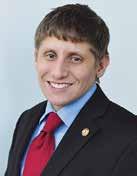
Dan Fraczkowski MSN, RN
The American Nurses Association (ANA), has declared 2018 the Year of Advocacy. With the upcoming primary and midterm elections, it is essential for nurses to participate in the political process and get out to vote. I encourage you to become aware of the issues, familiarize yourself with the candidates and what they have to say about healthcare. Every vote counts, as Virginians found out in the November 2017 election when one of their state legislative district elections ended in a tie with each candidate receiving 11,608 votes. If there is a candidate whom you support, consider taking that extra step to volunteer a few hours to knock on doors or make phone calls to participate in our democracy. Throughout the year, we are asking you to share photos on our social media channels using #2018YearofAdvocacy. The year will culminate with a cash prize awarded to the best photo representing advocacy, based on your votes!
Advocacy is not limited to the political process, it comes in all forms, whether you are at the bedside caring for your patients, in community settings, schools, or clinics. We participate in shared leadership to advocate for structures and resources to support the care team. Nurses also advocate in the boardroom to ensure those at the frontlines have the tools and resources to practice to the fullest extent of their education.
Join us this year in Springfield, for advocacy in action, as we lobby legislators to support nursing’s agenda at the state capitol on Tuesday, April 17th for Student Nurse Political Action Day or Wednesday, April 18th for Nurse Lobby Day. If you are a nursing student, consider attending the Student Nurses Association of Illinois Leadership (SNAI) Conference, with theme “Mission: It’s Possible: Be An Action Hero Through Nursing Leadership”- more info is online at www.snaillinois.com I look forward to seeing you at one of these upcoming events.
It is also essential that we recognize nurses of all types, LPNs, RNs and APRNs, who are doing outstanding work to advance the profession in Illinois (IL). Nominations for the annual IL Nurses Foundation (INF) 40 under 40 Emerging Nurse Leader Award are now underway, with online submissions closing on April 15, 2018. I encourage you to nominate a colleague who demonstrates exemplary professional practice and also makes an impact in the community or professional organizations. Visit www. illinoisnurses.foundation to learn more or nominate a nurse.
In case you have not heard, the Secretary of State has finally sent letters to all those who RSVP’d for the IL nurse license plate with information on how to order your plate! We are excited to start seeing the specialty nurse license plates on the road in IL. Thank you for your patience in this process.
Dan Fraczkowski MSN, RN President – ANA-Illinois @nursedanf
Nursing is an aging profession causing a shortage and increasing the demand for nurses. In addition, the demand for quality healthcare and patient-acuity levels are increasing exponentially. Nurses’ experience, education, and professional environment affect each of us in various ways. As the profession focuses on meeting patient needs and providing quality care in a multitude of specialized areas, we are also facing increased interpersonal violence as well as increased exposures to occupational hazards. It comes as no surprise that workplace safety is a widely-discussed topic in nursing. Although each of our stories is unique, there are identified common experiences that need to be addressed to improve workplace safety.
Thus, the strategic plan of the ANA-Illinois called for an Expert Panel on Workplace Safety. This panel, comprised of members with rich and varied nursing backgrounds, has been charged with the task of assessing Illinois nurses’ perception of workplace safety. They have worked as a team to create a comprehensive survey, which will provide data for the State of Illinois, and a foundation for improving and enhancing workplace safety. This survey series supports nurses and their patients in Illinois. Below is a summary of the data collected for survey two.
Survey 2: Incivility / Bullying Behaviors
When one enters a health care facility, one expects to see and experience professional behavior, yet news reports show us a different picture, a picture of incivility and bullying. The term incivility refers to rude speech or behavior. Synonyms include discourtesy, impoliteness, bad manners, disrespect, boorishness, and ungraciousness. The opposite of professional values and behavior. Bullying reflects using one’s power (physical or emotional) to intimidate, and to force another to do what one wants. The American Nurses Association (ANA) defines bullying as “repeated, unwanted harmful actions intended to humiliate, offend and cause distress in the recipient. This is a very serious issue that threatens patient safety, RN safety, and the nursing
professional as a whole” (http://www.nursingworld. org/MainMenuCategories/WorkplaceSafety/HealthyNurse/bullyingworkplaceviolence). Synonyms include to persecute, oppress, tyrannize, browbeat, harass, intimate, strong-arm, and dominate. Again, the opposite of professional values and behaviors. Yet nurses across America continue to report incivility and bullying as common behaviors in the workplace.
The ANA-Illinois Expert Panel on Workplace Safety received over 300 completed surveys from Illinois nurses, and results show continued experiences of incivility and bullying. One significant limitation of this survey is the lack of bedside nurse participation. Another email blitz sent out ANA-Illinois in January 2018 encourages bedside nurses to complete these surveys.
The majority of nurses who participated in this survey were predominantly female (96%), living (81%) or working (83%) in urban or suburban areas, hold a BSN or higher degree (84%), made more than $60,000.00 (55%) per year, and state they are middle age or older (62%). The following behaviors show a significant relationship to the above nurse profile. The following behaviors occurred 1-3 times in the past month:
• Leaders speaking or acting disrespectfully to them (r =.380, p = ≤ .01)
• Being the brunt of rude treatment from a peer (r =.349, p = ≤ .01)
• Being the brunt of rude treatment by a leader (r = .343, p = ≤ .01)
• Being the brunt of sarcastic remarks from a leader (r = .331, p = ≤ .01)
• Being yelled at by a peer (r = .314, p = ≤ .01);
• Being the brunt of sarcastic remarks from a physician (r = .264, p = ≤ .05)
• Being the brunt of sarcastic remarks from a peer (r = .257, p = ≤ .01)
• Being humiliated by a leader (r = .239, p = ≤ .01)
• Being humiliated by a peer (r = .233, p = ≤ .01)
• Being humiliated by a physician (r = .214, p = ≤ .01)
• Being yelled at by a leader (r = .187, p = ≤ .05).

ANA-Illinois Expert Panel on Workplace Safety has been hard at work defining how the association should address the most pressing issues facing nurses today. To understand the complexity and depth of those issues the panel developed a series of surveys.
We have had a great response from the initial 4 surveys but need additional responses from nurses who spend at least 50% of their workday in direct contact with patients.
If you meet this criteria, please take a few minutes to complete each survey. If you have done so previously, thank you, you do not need to complete the surveys a second time.
PART 1SAFETY IN THE WORKPLACE https://www.surveymonkey.com/r/ WORKPLACESAFETYPART1
PART 2INCIVILITY https://www.surveymonkey.com/r/ WORKPLACESAFETYPART2
PART 3SAFE HANDLING OF MEDICATIONS & HAZARDOUS MATERIALS https://www.surveymonkey.com/r/ workplacesafetysurvey3
PART 4VIOLENCE AND INADEQUATE SECURITY https://www.surveymonkey.com/r/ workplacesafetypart4
Watch for additional surveys. Survey links also available at www.ana-illinois.org



RN to BSN Completion for Nurses with an ADN or Diploma MSN Leadership & Management in Health Systems
• Online classes fit your schedule
• No campus presence required
• Affordable, competitive tuition
• Nationally Accredited
• RN to BSN students may transfer up to 90 of the 120 required credits and take courses full or parttime at a pace comfortable for you.
• MSN program requires 34 credits that can be completed in as little as 2 years and features a Leadership Project in a health care setting. No entrance exams are required for admission.

Call 920-465-2826 or email nursing@uwgb.edu Consult our website: www.uwgb.edu/nursing

The INF continues to strive to make this event a MUST ATTEND for all those in the nursing profession and its supporters. A very special thankyou to each of our major sponsors and our many donors, as well as the volunteers who worked to make this event a success. Thank you for all that you do to support INF!
Platinum Sponsors ANA-Illinois
Diamond Sponsors
Arthur L. Davis Publishing Agency Texas Roadhouse – Dyer
Table Sponsors ISAPN
Loyola University
Olivet Nazarene University
Maureen Shekleton
The Tom & Maria Connolly Family
Silver Sponsors
Hektoen Nurses
Alpha Beta Chapter of Sigma Theta Tau International
Bronze Sponsors
Ann O’Sullivan
Jackie Garcia
Cathy Neuman
Smits Funeral Home LTD
Stepping Stone Financial Patricia Wienski
General Sponsors
Walter Schultz Agency Inc
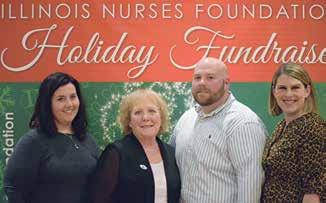

Silent Auction Donors
Alma Labunski
Amanda Buechel
Amanda Buechel Friend
Ann Marie Jagiella
Ann O’Sullivan
Aurelio’s Pizza
Brandon Hauer
Cheryl Anema
Chicago White Sox
Crystal Vasquez
Dan Fraczkowski
Grand Country Music Hall
JB Learning
Joanne Buckley
Karen Egenes
Kathy Serbin
Laurie Anema
Lettuce Entertain You Restaurants
Linda Roberts
Marcel’s
Maria Connolly
Maureen Shekleton
Mindy’s BBQ
Pam Brown
Par A Dice Casino
Pinot’s Palettes Naperville
Richard Flansburg Photography
Ruthann Sanders
Springer Publishing
Stonebridge Resort
Sue Johanson-Lentz
Susan Swart
Susanna Gonzales
Texas Roadhouse
The Cheesecake Factory
Walt’s Food
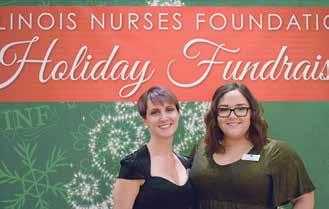
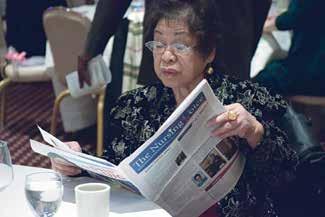



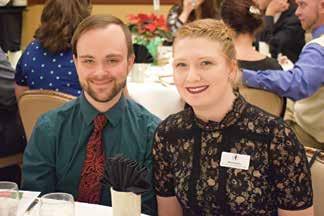
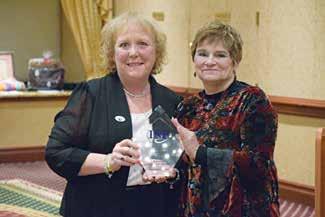




RN and APRN license renewal begins mid-March through May 31, 2018. The Illinois Nursing Workforce Center (formerly the Illinois Center for Nursing) will again be requesting participation in data collection by completion of a short survey. After completion of payment for Illinois RN or APRN license renewal, nurses will see the following message:
“We are requesting approximately 6 minutes (APRN will say 10 minutes) of your time. All data will be reported in the aggregate for use in determining nursing workforce projections and needs in Illinois. Individual responses will remain anonymous and confidential. Although this report is not mandatory, your participation is critical, since employees in the field are our best and most reliable real-time source of information available. By participating in this report, you will be helping to ensure that there will be an uninterrupted supply of nurses to meet the increasing future demands in the healthcare industry.”
Each survey captures data on the demographics, education, state distribution and practice foci in Illinois. The APRN survey also includes questions to collect data to be compared with data collected with license renewal in 2020. The plan is to evaluate the impact of changes in the Nurses Practice Act such as the number of APRNs practicing outside of a hospital who are no longer maintaining a collaborative agreement in their practice setting.
Why is data collected with relicensure? Because, according to the U.S. Health Resources and Services Administration (HRSA), state data based on licensure data holds more accurate workforce predictions. For example, the recent HRSA RN workforce report estimates a surplus of RNs by 2020 in particular states. The HRSA model is described as a micro-simulation model that assumes supply and demand for RNs was balanced in 2012, graduations will remain stable at the 2012 rate and employment patterns will not change notably. This is not true for Illinois, there was a shortage of RNs based on the 2011 demand study and the 2014 and 2016 RN reports indicate significant retirements. Thus, in Illinois there is reason to be concerned about the future supply of RNs.
Past reports, including the 2011 Supply-Demand data, are available on the Illinois Nursing Workforce (INWC) website http://nursing.illinois.gov
Public Act 100-0513 was signed into law in the Fall, 2017, with the new provisions beginning January 1, 2018. This recent legislation includes numerous changes to the Illinois Nurse Practice Act, including many changes to the APRN provisions.
In particular, PA 100-513 included changes that will allow APRNs that meet certain qualifications to practice without a collaborating agreement. To administer these new provisions the Department will need to update the existing APRN Rules and will need to develop forms and procedures to reflect these changes. The Department is currently drafting Rules and will file them in the near future.
The Act also included changes to the Continuing Education requirements for APRNs. The new CE provisions will also require a change to the Rules. Please note that the updated Rules will not be adopted before the end of the current license renewal cycle which ends on May 31, 2018. APRNs renewing their license in Spring 2018 will be required to confirm that they meet the existing CE requirements (a total of 50 hours).


RN and APRN renewal to open mid-March
The Illinois Department of Financial and Professional Regulation (IDFPR) is reminding licensed professionals that paperless licensing and renewals have been implemented for the 2018 Registered Nurse (RN) and Advance Practice Nurse (APRN) renewal period (mid-March through May 31, 2018). Submission of renewals for professionals must be completed online via IDFPR’s website (www.idfpr.com). For your convenience renewals on the website may be completed 24 hours a day. Please allow 2-3 business days for the processing of online license renewal.
Please note that all IDFPR correspondence are now delivered electronically, including renewal reminders (in lieu of the paper postcard). Licensees are strongly encouraged to visit IDFPR’s online address change webpage (https://www.idfpr.com/applications/ LicenseReprint/) to provide a current email address and ensure contact information is up-to-date and accurate. IDFPR encourages licensees to renew early to avoid any delays or lapses in licensing associated with late renewals. All RN and APRN licenses must be renewed by May 31, 2018; renew via IDFPR’s website (www.idfpr.com).
Once a renewal is successfully processed, licensees will receive an email confirmation and be provided access to a copy of their license that may be printed at any time, free of charge via IDFPR’s Online Services Portal (https://ilesonline.idfpr.illinois.gov/DFPR/Default. aspx).
For individuals with questions or concerns regarding licensure status or the renewal process, please contact IDFPR, toll free, at 1-800-560-6420 or by email: FPR. PRFGROUP09@Illinois.gov
Beginning January 1, 2018, Public Act 100-0564 requires all prescribers with an Illinois controlled substance license to enroll in the Illinois Prescription Monitoring Program (PMP) https://www.ilpmp.org/ through the Illinois Department of Human Services (IDHS).
Prescribers are additionally required to attempt to check the PMP prior to writing an initial prescription of a Schedule II narcotics, such as opioids. That attempt must be documented in the patient’s medical record.
The PMP is an electronic tool that collects information on controlled substance prescriptions, schedules II, III, IV and V. This data is reported on a daily basis by retail pharmacies dispensing in Illinois. The Mission of the PMP is to enhance a prescriber’ and dispenser’s capacity to review a patient’s prescription history for therapeutic and clinical reasons and to assist in the effective treatment of patients seeking medical care. The PMP was authorized by the Illinois Controlled Substances Act (720 ILCS 570/316) and strictly adheres to HIPAA and all access, disclosure and confidentiality provisions of Illinois Law.
The Illinois Department of Financial and Professional Regulation (IDFPR) will work with prescribers to ensure education and compliance with the new mandate. Prescribers not in compliance may be subject to disciplinary action by IDFPR.
For more information and to enroll as a prescriber in the Prescription Monitoring Program (PMP), please visit the IDHS website https://www.ilpmp.org/




When Governor Rauner signed Public Act 100-0513 into law last fall, changes to the Illinois Nurse Practice Act included a few changes for the Illinois Center for Nursing. Perhaps most notably is our new name, Illinois Nursing Workforce Center (INWC), which reflects the focus on the nursing workforce.
The Nursing Workforce Center was initially established through legislative action in 2006, and placed within the Illinois Department of Financial and Professional Regulation (IDFPR) to address issues of supply and demand in the nursing profession. Comprised of eleven members with diverse expertise, the Nursing Workforce Center is administered by a managing director. Since its inception, the INWC has established multiple coalitions with regional, state, and national organizations to address the statutory mandate.
Chairperson, Carmen Hovanec, MSN, RN and Vicechairperson, Kathleen Delaney, PhD, PMH-NP, FAAN wish to thank outgoing advisory board members: Julie E. Bracken, MSN, RN; Donna L. Hartweg, PhD, RN (past Chairperson); Mary M. Lebold, EdD, RN; Donna Meyer, MSN, RN; Maureen Shekleton, PhD, RN, FAAN (past Chairperson); and Deborah A. Terrell, PhD, FNP-BC, RN. In addition to C. Hovanec and K. Delaney, continuing board members include: Marsha A. Prater, PhD, RN, NEA-BC, FACHE and Corinne Haviley, MS, PhD, RN. New advisory board members will be appointed by IDFPR Secretary Schneider.
The Illinois Nursing Workforce Center is working with industry professionals and educational institutions to ensure that Illinois has a nursing workforce necessary to meet the demands of a growing and aging population. Visit the INWC website, www.nursing.illinois.gov
Eli Heicher MSN, RN, CENP
Introduction





Many variables affect clinical ladder programs, creating a significant challenge when trying to show the success of clinical ladder programs. Many of these variables emerge from the fact that nurses have the autonomy to make their own decisions when it comes to clinical competence. There could be multiple reasons why a nurse decides to seek employment at a specific institution, and multiple reasons to continue employment over an extended length of time. Multiple factors influence how nurses characterize their satisfaction within their current careers and/or nursing positions. Demonstrating that implementing a clinical ladder program is the sole or major factor in the success or failure in many of the areas that affect nurses emerges as the central post-literature review problem. In the dissertation The Development of an Instrument to Measure the Perceived Effectiveness of Clinical Ladder Program in Nursing, Strzelecki (1989) writes, “much of the literature available on clinical ladders describes the proposed outcomes, suggested frameworks, and maintenance of clinical ladder. Little has been written about their effectiveness. An assessment tool which would measure the effectiveness of a clinical ladder program in supporting a professional environment for nursing practice is needed” (p. 6). While Strzelecki appropriately highlights the importance of evaluating the use of a clinical ladder program, the method of evaluation that she proposes and uses may not be the most effective in the evaluation of such a program. Strzelecki even acknowledges in the title of her dissertation - “The perceived effectiveness” - that implementing a clinical ladder program does not guarantee results and can be cause for concern when it comes to reliability. Given the complexity of motivations at play in employee retention and performance, properly characterizing the outcome of clinical ladder programs may be a challenging task, but what is certain is that a more reliable tool and/or method of evaluation of clinical ladder program needs be considered. Corly et al, (1994) further reinforces this point, stating that the measurement of clinical ladder system as a whole has been very limited with most clinical ladder evaluation only stating that the programs are effective and providing little data to back these facts up (p. 42). The design of this Critical Literature Review is a statistical analysis of current and past literature reflecting outcome measurement of clinical ladder programs. Because of the lack of up-to-date literature on this subject, some of the articles that were reviewed are from significantly older sources than desired. However, when gaining insight into the beginning of clinical ladder programs, it was important to research historical sources. There
was a clear division in research studies into two subsets. These included subjective or qualitative studies and objective or quantitative studies. The qualitative studies focused on research conducted via questionnaires and or surveys, while the quantitative studies focused on data and outcomes analysis. The review articles were largely composed of qualitative studies, with most of their information comprised of opinion based surveys or questionnaires related to nurse’s perceptions of the clinical ladder process. The use of objective and statistical data would provide more confirmation about the success of clinical ladder programs, but that remains challenging because there are so many variables involved. In order to differentiate the success of a clinical ladder program each specific detail needs to be evaluated. These differential details may include the type of reward used, how to get program participants involved, criteria of program, model of program used and many other factors. A greater quantitative research focus would provide a more measurably accurate method of showing these programs are warranted, worth the cost implementation, and most importantly, successful. Quantifiable data would constitute an important step toward answering the questions that currently surround clinical ladder programs: Is there any hard or concrete evidence available to validate that clinical ladder programs are worth the considerable cost they produce for organizations? Can these costs be justified when it comes to deciding to start such a program within any institution?
There is not a large amount of statistical research found about the return on investment that clinical ladder programs make. Can organizations justify the cost of implementing these programs? Solely basing a review of clinical ladder programs on costs spent for recruitment and turnover is limiting because it does not encompass the entire spectrum of benefits that the program can achieve. However, when one takes into account some of the other factors, it becomes an easier argument. Of primary significance are improved patient outcomes. In addition to improved care, most of research found on clinical ladder programs reported that such programs are a large staff satisfier, creating an even more compelling argument for their use. Clinical ladder programs appear to provide opportunities for nurses to grow and improve clinical skills. It may be that it does that better than other reward and recognition systems. Depending on the study, they may also provide monetary success as well. Maier (2002) describes significant cost reduction due to clinical ladder program implementation. While Schultz’s (1993) study does show a loss associated with their clinical ladder program, they also describe several limitations
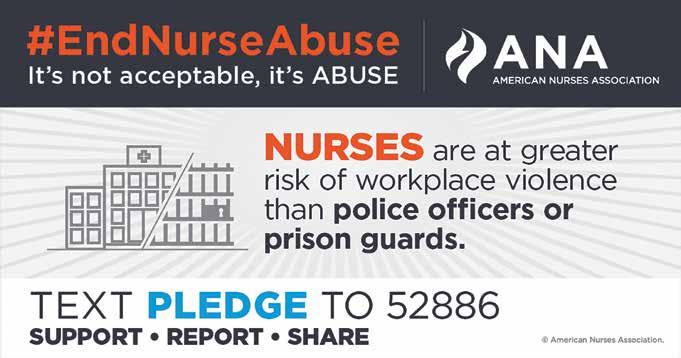
associated with the research which were not taken into account. Schultz states that these limitations are related to the fact that there are so many components that need to be evaluated not only staff turnover. One of the most significant factors helping clinical ladder programs success is that the American Nurses Associations “magnet” award is partially based on whether organizations have reward and recognition programs in place like that of the clinical ladder. There is a great deal of significance based on the fact that clinical ladder programs have not been recently studied to the extent that they should be, especially when taking into account that these reward programs cost healthcare facilities millions of dollars annually.
After an extensive evaluation of clinical ladder program studies and research, it was evident that pre and post implementation data must be recorded and evaluated. Based on this evaluation, there were only a couple of research studies completed that used statistical data from both pre and post implementation, and in one of these cases it involved Certified Nursing Assistants and not Registered Nurses. The most comprehensive reviews of successful previous programs on the clinical ladder process utilized a significant amount of data, but it was subjective in nature and provided little hard facts or financial evaluations. Searches related to any information written by the ANA reevaluating the use of clinical ladder programs since the mid 1980’s were not successful. A thorough evaluation of the clinical ladder system needs to be completed in order to provide institution and administrators recommendations for implementation and reevaluating these programs. There was a significant amount of research pointing to the fact that clinical ladder programs are worth the cost; however, there was no research found on what type of clinical ladder programs or models were most effective. There was also little written about how a clinical ladder program needs to be reevaluated.
Viewed broadly, with implementation in many settings and over the course of many decades, clinical ladder programs have undoubtedly helped to bolster positive outcomes for nursing staff, institutions, and patients alike. Cote (2007) sums this up nicely by stating that reward and recognition such as what a clinical ladder program provides help to improve nurse satisfaction and retention (p. 247). We know that programs like this work; however, quantifying clinical ladder program outcomes remains extremely difficult. Many institutions implement these programs based upon current trends among other healthcare organizations and complete little if any analysis of the need for a clinical ladder system prior to putting them into place. This was the case at Sarah Bush Lincoln Hospital in Mattoon, Illinois. They did not adopt a clinical ladder program until 2012. Additionally, once implemented, there appears to be very little data on the sustainability of such programs and how organizations might optimize their usage. While the ANA provided some direction for the clinical ladder process, this information was published over 20 years ago. This critical literature review found far more positives related to implementation of clinical ladder programs than it found negatives. Both subjective and objective data were overwhelming positive, supporting the use of clinical ladder programs. Harton, Whichello and Hammond (2010) state, “nurse leaders must advocate for programs that reward nurses for ongoing contributions above the essential role accountabilities of the job” (p. 15). Bourgeault and Newmark (2012) discuss some of the key items needed from clinical ladder program to be successful. These include understanding the time commitment, organizational support, as well as administrative buy-in and staff buy-in (pp. 35-36). Organizations that are considering a clinical ladder system need to understand that for clinical ladder programs to be financially viable, they need to be continuously evaluated and promoted. Clinical Ladder programs have helped to pave the way for healthcare organizations and nursing administrators to explore other employee development programs that might be useful in helping to recruit and retain nurses. Many organizations are now looking at clinical ladder programs as options to help to retain the largest nurse turnover population, that of new nurses with less than 1 year of experience (Drenkard & Swartwout, 2005, p. 504). RN development programs and residency programs are also starting to become very popular. This is based on the fact that organizations are now starting to understand that growing and developing nurses internally have greater retention and employees that are vested within the organization. In order to stay competitive, an organization must find the type of professional development program that fits its unique needs. Another major discovery indicates that the more nurses are individually involved in the clinical ladder process, the higher their perception of the program (Ward & Goodrich, 2007, p.171). As a result, the more nurses that an organization gets involved in a clinical ladder program, the more rewards from the program that institution is
likely to see. Further options for increasing awareness and ultimately participation in clinical ladder programs need to be explored. Some possibilities are by using a shared governance approach when planning or revising a clinical ladder system and by also automatically enrolling nurses into the program when they are hired. By using these approaches it can help to improve utilization and satisfaction. It is critical that leaders understand their clinical ladder programs and continually discuss them with those who are truly involved in using these systems. Continually reevaluating these programs improves the likelihood that they will remain meaningful and effectively utilized by staff. Harton, Whichello and Hammond (2010) state, “clinical ladders have been employed in many settings but have encountered problems, not the least of which is the continued motivation of the individual to excel, grow, and learn” (p.17). It is paramount that institutions don’t let their clinical ladder programs go dormant. They need to be reevaluated on a routine basis by the nurses who use them. An ongoing quantitative review of program outcomes would provide program direction in the reevaluation process. Clinical ladder

One of the most important components of a successful implementation and getting any system like a clinical ladder program up and running and maintaining it is having employee buy-in. Cote (2007) makes a great point when discussing clinical ladder programs and nurses participation. She states that what makes clinical


ladder programs uniquely challenging is the fact that nurses get to choose whether they want to participate in the programs or not (p. 247). Participant choice allows motivated nurses to become very involved in the process while potentially discouraging others from becoming involved. A successful clinical ladder program really starts with the development of the program. No matter how carefully drawn up and designed, without input from front line staff, implementation and maintenance can remain challenging. Woolsey and Bracy (2012) reinforce the criticality of gaining the input of those who will be participating in the program, demonstrating that even the most well thought out program has a great potential to fail if there isn’t front line staffs participation. After presenting a clinical ladder program to staff for a number of years and having it be poorly received, they started to ask staff why. Staff reported that it was because they were not involved in the process of designing, implementing and evaluating the program (p. 49). If a clinical ladder program is going to reach its maximum potential, it is critical to get front line staff involved in developing and implementing the program. Many institutions build clinical ladder program evaluation teams into their global nursing committees. Sarah Bush Lincoln Hospital uses a shared governance approach to clinical ladder adoption and evaluation has proven to be very useful for organizations. If programs like this are put into
Continuing Education Offering continued on page 8


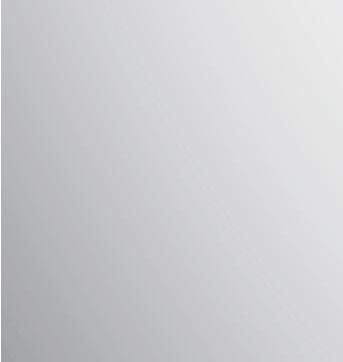







place to improve and promote workforce engagement and aid in retention, it is vital for that target audience to be involved in constructing and maintaining such programs. Many surveys and questioners sent to staff pertaining to retention ask little about the involvement of staff in the development of a clinical ladder program. They focused more on whether the perception is that clinical ladder programs are meaningful and less on what ways nurses might use clinical ladder programs to make the program meaningful and fulfilling. An article written by Winslow et al., (2011) states
“as it had been nearly 20 years since a revision had been made to the clinical ladder program, communication with the nursing staff regarding program changes was a crucial element in the implementation process” (p. 14). When reevaluating clinical ladder programs, it can be extremely useful to look at the demographics of nurses using them. For example, Tetuan, Browder, Ohm and Mosier (2013) find that nurses who participate in clinical ladder programs are those that tend to have more experience and usually work on the day shift (p.8). Day shift nurses may be more apt to participate in these programs for a number of reasons primarily related to their visibility as employees and the assistance that visibility affords. As a result, nurse administrators must improve efforts to disseminate information about clinical ladder programs to all shifts, actively encouraging the participation of all employees, not just those who work the day shift.
When starting to research clinical ladder programs, it was quite evident that there are as many nuances and differences between clinical ladder programs as there are different nursing career paths. The success or achievements made by implementing a clinical ladder program can essentially be divided into three main components. First, clinical ladders benefit organizations through increased engagement, recruitment, retention, and/or professional development. Next, clinical ladder programs benefit the individual nurse through financial gain, professional development, and increased job satisfaction. Lastly, clinical ladder programs benefit the patient or customer, the element most difficult to verify and, therefore, most often overlooked. Patient outcomes are generally improved through increasing staff satisfaction, improved nurse credentialing, and obtaining certifications. Additionally, some of these components can be a benefit for the institution, nurse, and patient. This is highlighted in the clinical ladder program started by Sonora Quest laboratory. Garlettis (2002) describes the success of this program in depth. He describes how staff call-ins and staff turnover plagued their institution. Their unit recorded 15 percent absenteeism and over 65 percent annual turnover rates. This situation led to an immediate need for evaluation and change. A robust clinical ladder system was implemented in the laboratory and at the one year mark showed significant improvement and results that not only were cost effective, but improved the lab’s work environment. By making inclusion into the clinical ladder program mandatory for all employees and not grandfathering in current employees, Sonora Quest laboratory was able
to include training and structural elements into the clinical ladder program curriculum that might have been hard to implement if not part of the process. The clinical ladder program was supported from all employees as it allowed those who successfully completed required training to be advanced within the clinical ladder program and subsequently rewarded them for the education completion. The most significant improvement was noted in turnover rate, improving by 20 percent. Absenteeism significantly improved as well (Garlettis, 2002, pp. 380385). In this particular program, the organization, patients or customers and employees all benefited from the implementation of the clinical ladder program.
This critical literature review of clinical ladder programs explored a number of questions in regards to whether these programs are effective and financially viable. An overwhelming response to these questions was positive. They promote staff satisfaction which in turn helps with recruitment and retention of nurses. Clinical ladder programs also help to provide an environment that fosters continual growth and improved clinical outcomes, ultimately leading to better patient care. There were also unexpected results that were discovered from this review. First, clinical ladder programs help to decrease employee absenteeism (Jennings, 2008, p. 1). Clinical ladder programs have also been shown to provide an avenue for nurses to be involved in evidence based practice within organizations, and that can help to significantly improve institutional outcomes and professional practice.
There were also some questions that arose that could prove to be useful for future clinical ladder programs. First, what method or model of clinical ladder program appears to be the most effective? There is little to any comparative research completed on this question within clinical ladder programs. There is a great deal of difference between Benner’s clinical ladder model and the newer Synergy model. The Synergy model’s holistic approach allows for a much broader use for the clinical ladder model. However, further research needs to be completed in order to fully understand the complexity and differences in clinical ladder models and which are most effective at optimizing retention, employee satisfaction, and patient outcomes over other models of clinical ladder design. Understanding this might help to answer what clinical ladder program model would be most helpful in meeting an organization’s needs. Next, research through this critical literature review showed that reformatting and or restructuring clinical ladder programs periodically can be very effective at maintaining or improving their overall effectiveness. Further research is needed to properly evaluate at what point this restructuring should be completed.
The last issue worth exploring is whether the increased use of clinical ladder programs has decreased their effectiveness. While clinical ladder programs have undoubtedly become the norm, it is difficult to argue that they have or haven’t lost their effectiveness. Although the limited research currently available indicates that clinical ladder programs increased usage and exposure have most likely improved its overall course, understanding and the acceptance of the programs, more research needs to be completed to have a clear understanding of how clinical ladder programs effectiveness has increased or decreased as they have become more popular.

CE Offering
1.0 Contact Hours
This offering expires in 2 years: March 10, 2020
Learner Outcome:
After reading the article, the nurse will be able to describe the basics of two clinical ladder models and how they assist recruitment and retention efforts.
HOW TO EARN
CONTINUING EDUCATION CREDIT
This course is 1.0 Contact Hours
1. Read the Continuing Education Article 2. Go to https://ilnursesfoundation.wufoo.com/ forms/mar-2018self-study/ to complete the test and evaluation. This link is also available on the INF website www.illinoisnurses.foundation under programs.
3. Submit payment online.
4. After the test is graded, the CE certificate will be emailed to you.
HARD COPY TEST MAY BE DOWNLOADED via the INF website www.illinoisnurses.foundation under programs
DEADLINE
TEST AND EVALUATION MUST BE COMPLETED BY March 1, 2020
Complete online payment of processing fee as follows:
ANA-Illinois members- $7.50 Non members- $15.00
ACHIEVEMENT
To earn 1.0 contact hours of continuing education, you must achieve a score of 80%
If you do not pass the test, you may take it again at no additional charge
Certificates indicating successful completion of this offering will be emailed to you.
The planners and faculty have declared no conflict of interest.
ACCREDITATION
This continuing nursing education activity was approved by the Ohio Nurses Association, an accredited approver by the American Nurses Credentialing Center’s Commission on Accreditation. (OBN-001-91)
CE quiz, evaluation, and payment are available online at https://ilnursesfoundation.wufoo.com/ forms/mar-2018self-study/ or via the INF website www.illinoisnurses.foundation under programs.


The funding we receive from the license plates will help the Foundation launch our grant program for nurse-initiated projects. Those that RSVP’d have been notified of the plates availability and were able to preorder. The plates should be made public soon. Again, Thank You for your support and patience during this process! Watch for further developments and announcements.

Nationally, there are over 50,000 CRNAs that deliver over 43 million anesthetics each year. CRNAs have a long history of providing anesthesia for over 150 years. The Illinois Association of Nurse Anesthetists (IANA) began its history in 1939 with the philosophy committed to fostering high educational standards and practice in the art of Nurse Anesthesia. In Illinois, there are currently over 1,500 Certified Registered Nurse Anesthetists (CRNAs).
These CRNAs rise to the challenges of meeting the anesthetic needs of patients. In Illinois, CRNAs are the sole anesthetic provider in 29% of counties, but are the principal practitioners in 89%. Furthermore, 31 counties have no registered anesthesia providers and 74% of those counties are encompassed by primarily CRNA providers. Illinois’s CRNAs meet the needs for access to quality and cost-effective anesthesia services. They are the principal provider in rural areas and allow healthcare facilities to provide obstetrical, surgical, pain and trauma stabilization. Additionally, CRNAs improve access to care for the underserved population, military personnel and in Veteran Affair facilities.
The 2017 legislative year proved to be a challenge for Illinois’ CRNAs. HB 3382 would remove the requirement from the state’s laws that a physician, podiatrist or dentist “remain physically present and be available on the premise during the delivery of anesthesia.” This legislation would have given the CRNAs in Illinois greater autonomy. The Illinois Society of Anesthesiologists (ISA) introduced HB 2975 to license anesthesiologist assistants. This legislation would have added another group of practitioners in
the art of anesthesia. However, negotiations kept both pieces of legislation in committee.
On a positive note, Senator Pamela Althoff received the 2017 IANA Legislator of the Year Award . On December 12, 2017, President Rose Slowikowski, CRNA, DNP presented the award to Senator Althoff in Chicago, Illinois. Senator Althoff is a strong advocate of the nurse anesthesia profession and sponsored SB 1094. Her staunch support helped pass this crucial piece of legislation in a short amount of time. SB 1094 extended the Grandfathering provision (July 1, 2018 to July 1, 2023) to currently licensed CRNAs without a master’s degree and allowed their continued ability to unrestricted practice.
On September 20, 2017, Maria struck the island of Puerto Rico as a Category 4 hurricane. The devastation that ensued is well-known to the US. The IANA and Student Registered Nurse Anesthetists (SRNAs) saw an opportunity to support SRNAs at the three programs Puerto Rico. Creation of a Go Fund Me page raised over $1,200 to purchase much needed items, such as reading lamps with battery backup, solar chargers for electronic devices, and LifeStraw water bottles with replacement filters.
As you can see, CRNAs are a critical part of the evolving healthcare market for the great state of Illinois. The IANA looks forward to a future that ensures critical access to quality and cost-effective while being part of the solution to the healthcare crisis. More importantly, the IANA looks forward to any collaboration that further promotes healthcare in Illinois.
Precision medicine has been a buzzword in health care circles for years now – but the National Institutes of Health (NIH) is poised to launch a major new research effort that will make it a reality. The All of Us Research Program seeks to enroll one million or more participants who will share their health information and begin a new era in medical research and treatment
Two major goals set this NIH effort apart from typical medical research. First, they aim to have 50 percent of participants from racial and ethnic minority communities. Second, they aim to have 75 percent of participants from groups that have been historically underrepresented in research. Achieving these goals will require significant effort to build trust, overcome barriers, and work with participants as true partners in research.
The All of Us Research Program is not one single health study; it will be a database that researchers can use to run thousands of health studies. The data collected can be used by any researcher in the U.S. and around the world, as long as they follow strict privacy and security rules. We hope that researchers will use this data to achieve a wide range of medical breakthroughs.
Health care providers have a critical role to play in this effort. Based on our commitment to community outreach in order to reduce health disparities within the Hispanic population of the United States, NAHN-Illinois is excited to help spread the word about this program and ensure that our members are educated about its promise and accomplishments over time.
“All of Us has the potential to redefine the future of health in the United States,” said Liz Aquino and Wanda Monterrubio from NAHN-Illinois. “We’re excited to work with the NIH to ensure that this program brings together communities throughout the United States to drive better outcomes, earlier disease identification and precise treatment solutions."
To learn more about the program, including what it means to be a participant, please visit https://allofus.nih.gov/
Nurses from the NAHN-Illinois Chapter, and across the U.S. have eagerly volunteered to help the people living in Puerto Rico who are faced with limited access to clean water, food, electricity, and medical assistance after Hurricane Maria. NAHN-Illinois collaborated with Norwegian American Hospital, New Life Church, and Angels of the Kind to send two teams of volunteer nurses, doctors, and other health care providers with medications and medical supplies to Puerto Rico. They were able to care for people living in various parts of the island and saw over 400 patients. We are planning to continue to send more nurses over the next several months to assist with the much-needed medical relief.
NAHN-Illinois Immediate Past-President, Susana Gonzalez, shared this about her experience after participating in the medical mission: We believed we were a small but mighty medical mission team destined to give services to where
God’s people needed us. We returned a strong family transformed by our phenomenal experiences together. We got up at dawn and worked as a team that collaborated, supported, comforted, and healed many residents who needed services for hours every day. We touched hundreds of lives. We made a difference. We returned changed individuals and a strong family for life. Puerto Rico has left an imprint in our hearts we take to eternity.
A special thank you to the NAHN nurses who volunteered their time, skills, and healing hands to assist with the medical missions: Jenifer Crespo, Raquel Diaz, Susana Gonzalez, Nitza de Pedro, Juana Quinones, Paulina Zapata, and Liz Zimnie. For more details or to provide a donation to support the medical mission please go to www.nahnillinois.org/puerto-rico-hurricane-relief.html
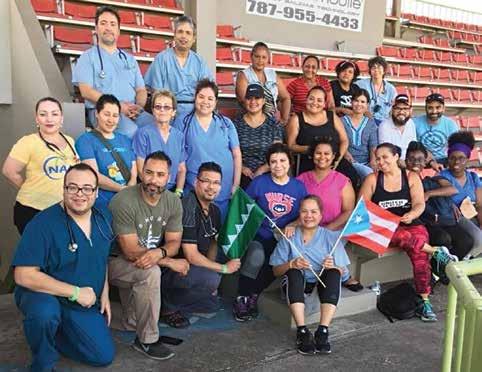


Through the generous donations of individuals, we honor the following nurses:
Mary Lange-Alberts
Sharon Bartmer
Nikki Burbey
Margaret Faut Callahan
Karen Egenes
Ruth Fluke
Dan Fraczkowski
Susan Fulara
Rocio Garcia
Rhys A. Gibson
Constance Girgenti
Susana Gonzalez
Joyce Keithley
Vicki Keough
P. Joan Larsen
Rosa Leland
Ricki Loar
































Marcia Maurer
Michelle Miller Lynn
Chrystal Manning
Jane Peterson
James Price
Linda Ruholl
Toni Scott
Maureen Shekleton
Lonnie Sturkey
Susan Swart
Jackie Witges
Laura Weigand
Kathryn Weigel
Memorial Donations
Dianna McCoin, LPN
Lonnie Sturkey










































The Student Nurses Association of Illinois is gearing up for their annual Leadership Conference. Join us on March 24th for “Mission: It’s Possible – Be an action hero through nursing leadership!” This year students will have the opportunity to hear from state-wide nurse leaders about their initiatives and ask the SNAI Board of Directors about their road to and experience with leadership. Most importantly, students will have the ability to collaborate with their peers, discuss how the speakers’ experiences reflect their own, identify potential opportunities for growth, and brainstorm solutions to current barriers. Follow us on Facebook at http://www.facebook.com/SNAIllinois for our weekly countdown to Leadership! Each week we’ll highlight the leadership roles of one of our Board members.
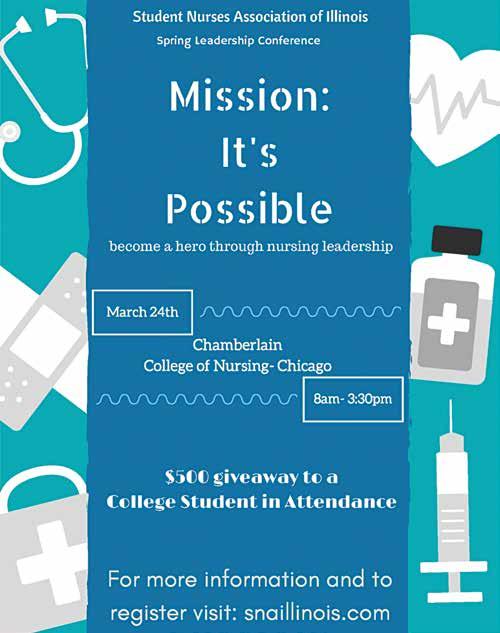








RECENT EVENTS
In conjunction with Ambria College of Nursing, the APNA Illinois Chapter hosted a conference entitled “Empower. Energize. Inspire: A Conference for Psychiatric Mental Health Nurse Educators” on Friday, November 3, 2017. Nurse educators from around the state enjoyed dynamic speakers who shared their teaching expertise. Dean Georgine Berent hosted the day and nursing student volunteers made sure the attendees were well cared for. Topics included factors leading to outstanding teaching, establishing a therapeutic alliance with patients who have schizophrenia, preparing a therapeutic teaching toolkit, reducing stigma by inspiring empathy, selfcare for the nurse educator, team-based learning an innovative teaching strategy, and the male perspective in nursing education. Northern Illinois University and Johnson & Johnson sponsored the conference and attendees enjoyed a catered breakfast, lunch and 5.75 continuing education contact hours. A future conference focusing on nursing education will be planned for Fall 2018, so stay tuned!
SPRING CONFERENCE
The 17th Annual Illinois Chapter of the American Psychiatric Nurses Association (APNA) Conference is coming this spring! “Whole health begins with mental health”
Friday, April 27, 2018 from 8:30 am – 6:00 pm NEW LARGER SPACE--Northwestern Memorial Hospital Feinberg Conference Center, 251 E. Huron Avenue, Chicago, Illinois 60611
Next month, over 250 psychiatric RNs, APNs, and students will gather in Chicago for this day-long conference. The conference is just steps from Chicago’s Magnificent Mile and Navy Pier. This day-long meeting includes:
• Top nurse researchers & clinicians
• Buffet breakfast & lunch
• After conference reception
• Free validated parking
In addition, there are opportunities for psychiatric nurse researchers to present posters.
The Keynote will be presented by international awardwinner David Granirer, Consumer, Comic, Founder of Stand Up for Mental Health - a program that teaches stand-up comedy in three countries to people with mental illness or mental health issues as a way of building confidence and fighting public stigma.
Other topics include: Integrating psychiatric services in primary care, perinatal women’s health, pharmacogenomics, physical effects of psychotropics, RN self-care, and more!







Accreditation statement:
This activity has been submitted to the Ohio Nurses Association for approval to award CNE contact hours. The expected number of hours awarded will be 7.8 hours.
The Ohio Nurses Association is accredited as an approver of continuing nursing education by the American Nurses Credentialing Center’s Commission on Accreditation (OBN-001-91).
To receive contact hours for this event, you must attend the entire event and submit a completed evaluation form.
The planners and speakers have declared no conflict of interest.
Save the date - Coming up in June!
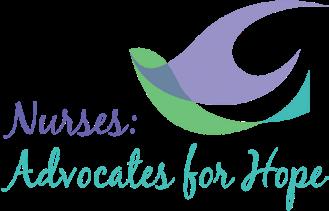
APNA Competency Based Training for Suicide Prevention
Psychiatric-Mental Health Nurse Generalist Role
Become a card-carrying APNA Suicide Prevention Provider!
Learn to systematically apply the first suicide prevention competencies developed for psychiatricmental health nurse generalists to your practice! This live* interactive training, presented by a facilitator with expertise in suicide prevention, will increase your confidence and competence in the nursing skills of suicide assessment, management and prevention. Get evidencebased nursing knowledge and best practices from this content developed to improve the knowledge, attitudes, skills and critical thinking of psychiatric-mental health nurses caring for persons at risk for suicide.
*Includes 1.25 hours of online pre-work - overall awards 6.5 CEs.
Target Audience: Generalist nurses who care for persons with mental health disorders in an inpatient setting.
June 22 - Linden Oaks Mill Street location Naperville, IL Check APNA.org/Illinois/events for details and how to register






Welcome to 2018: a time of great change for all APRNs in Illinois. As we move forward with the process of the elimination of the written collaborative agreement (WCA), there are some important things to keep in mind. First and most importantly, this is a process, and one that will take some time to complete. While the Nurse Practice Act (with stipulations for elimination of the WCA) was signed by Governor Rauner in September 2017, the Rules still need to be written. The Rules will delineate the process of enforcement, and because of this, we are not able to eliminate the WCA until after this process has been completed. The Rules are currently being written – and ISAPN continues our presence, involvement, and advocacy. Following the development of the first draft of the Rules, there will be a period of public comment. Currently the anticipated timeline is February 2018, but as with everything in government processes, it is a wait and see game. Following the period of public comment, revisions may need to be made to the Rules, and then there will be an additional period for public comment. These are processes that cannot be avoided or shortened. It is our hope and expectation that this process will be completed during the summer 2018. Please be aware of this period of public comment, and voice your concerns, suggestions, and questions! The Rules can be reviewed either through the Illinois Register: http:// www.cyberdriveillinois.com/departments/index/register/ home.html or through the Finn Report: http://www.ilga. gov/commission/jcar. You can also register at the ISAPN Advocacy Portal for updates and information.
The next topic of importance is that it is crucial for you as an APRN to be informed! There are several ways for you to be informed of all changes to our practice.
• The first is to become a member of ISAPN. You will receive frequent emails with the most current news.
• The second way is for you to register for the ISAPN Advocacy Portal. If you haven’t registered for the ISAPN Advocacy Portal, do so right now at http:// cqrcengage.com/ilnurses/home?0
• Another way for you to get the most current information is to work with your facility and invite ISAPN to do an APRN Update at your place of employment or to watch for announcements about other events. This is an excellent way to learn the most up-to-date information, to have your questions answered, and to earn 1.0 hour of CE.
I am excited about our professional practice and future in Illinois, and look forward to these changes!
Ricki Loar, Ph.D., APRN
President, ISAPN


































Debra Shore Commissioner, Metropolitan Water Reclamation District of Greater Chicago
ShoreD@mwrd.org (312) 751-5692
You might be wondering why a Commissioner from the Metropolitan Water Reclamation District (MWRD)—one of the world’s largest wastewater treatment agencies—is writing in The Nursing Voice. I believe we have shared goals: to protect public health and our environment through proper medication disposal. Unfortunately, medications pose serious threats to patients and the water environment when not disposed of promptly or properly.
The opioid epidemic continues claiming lives. The Illinois Department of Public Health reported 1,266 deaths due to overdoses of opioid analgesics—more than twice as many as were reported in previous years.1 Nurses see how pharmaceuticals improve the lives of patients every day, but we also know that many prescriptions go unconsumed. Millions of Americans abuse prescription medications, often reaching for the free and forgotten contents of family medicine cabinets. Patients should remove unused medications regularly, but proper disposal is necessary to prevent environmental harm.
Pouring medications down the drain, flushing them down the toilet, or tossing them in the trash contaminates our precious water resources. While human excretion accounts for an estimated 90% of medications in waterways 2, improper disposal remains a significant pollution pathway. Wastewater treatment agencies cannot fully remove pharmaceuticals enter their plants, so small concentrations spill into rivers and streams with the treated discharged. Scientists are finding pharmaceuticals in waters around the world, including traces of norfluoxetine, diphenhydramine, diltiazem, carbamazepine, ciprofloxacin, codeine, fluoxetine, gemfibrozil, ibuprofen, naproxen, and thiabendazole in Chicago’s fish3 and wastewater effluent4 . Medications in landfills are still dangerous—even when mixed with kitty litter in sealed containers—because they leach into groundwater. As a Commissioner at the MWRD, I’m all too familiar with the real environmental problems posed by pharmaceuticals being flushed away or thrown in the garbage and ending up in our rivers, streams, and lakes.
Patients should dispose of medications at designated collection bins or take-back events. These options are free, legal, and confidential, and collected medications are incinerated at EPA-approved facilities. The Illinois Environmental Protection Agency maintains a statewide map of collection sites at www.epa.illinois.gov/ services-locator. Cook County residents can find nearby locations at www. cookcountysheriff.org/prescription, or by calling 1-84-GOT USD RX (1-844-6887379).
Health care professionals should educate their patients and identify convenient collection sites, prominently displaying information about locations, websites, and phone numbers. Also, consider contacting the United States Drug Enforcement Agency to learn more about how to install a receptacle in your own office. Proper medication disposal is an easy way to keep patients and the environment healthy.
1 Illinois Department of Public Health. (2018). Drug Overdose Deaths by Sex, Age Group, Race/Ethnicity and County, Illinois Residents, 2013-2016. From: http://www.dph.illinois. gov/sites/default/files/publications/Drug-Overdose-Deaths-January-2018.pdf. Accessed: January 10, 2018.
2 Snyder, S., Lue-Hing, C., Cotruvo, J., et al. (2010). Pharmaceuticals in the Water Environment. From: https://www.acs.org/content/dam/acsorg/policy/acsonthehill/ briefings/pharmaceuticalsinwater/nacwa-paper.pdf. Accessed: January 10, 2018.
3 Ramirez, A. J., Brain, R. A., Usenko, S., et al. (2009). Occurrence of Pharmaceuticals and Personal Care Products in Fish: Results of a National Pilot Study in the United States. Environmental Toxicology and Chemistry, Vol. 28, No. 12, pp. 2587-2597.



4 Metropolitan Water Reclamation District of Greater Chicago. (2013). Report No. 14-20: Concentrations of Pharmaceutical and Personal Care Products in Influent, Effluent, and Waste-Activated Sludge and Biosolids in the Metropolitan Water Reclamation District of Greater Chicago’s Seven Water Reclamation Plants.



Nurses play a critical role in the lives of patients across the country. That is why the U.S. Department of Health and Human Services is dedicated to providing you, policy makers, and researchers with the most comprehensive data on U.S. registered nurses and nurse practitioners. To accomplish this, we need your help. Please support and encourage participation in the 2018 National Sample Survey of Registered Nurses (NSSRN). This vital national survey is the primary source of data on the nursing workforce, the largest group of healthcare providers.
The Purpose of the Study
The NSSRN will gather up-to-date information about the status of registered nurses in the U.S. These data will be used to describe the registered nurse population at both the national and state level, so policymakers can ensure an adequate supply of registered nurses locally and nationally.
Data Collection
The NSSRN will be sent to over 100,000 registered nurses in March of 2018. Nurses will be able to fill out the survey electronically or through a paper questionnaire. It is imperative that nurses participate and send back as soon as possible.
The Survey Contractor
HRSA has contracted with the U.S. Census Bureau, the leading statistical federal agency in the United States. Census has assembled a team of expert survey methodologists responsible for gathering the lists of licensed RNs, constructing the national sample, and administering the survey by mail, and on the internet.
Did you Know?
Did you know…employment settings change as nurses age? The vast majority of registered nurses under 30 years old work in hospitals, but over 50 percent of registered nurses 55 years or older work in non-hospital employment settings. Information like this from the NSSRN survey helps policymakers and healthcare leaders plan for future staffing needs.
The Survey Results
We plan to release the public use file from the 2018 study by January 2019. A report from the 2008 study is available at http://bhw.hrsa.gov/healthworkforce
Endorsements
The following nursing organizations have endorsed this survey. The National Council of State Board of Nursing and individual state boards of nursing have generously provided mailing lists for the survey.
American Academy of Ambulatory Care Nursing
American Association of Colleges of Nursing
American Association of Nurse Anesthetists
American Nurses Association
American Organization of Nurse Executives
National Association of Hispanic Nurses
National Black Nurses Association, Inc.
National Council of State Boards of Nursing
National League for Nursing
National Organization of Nurse Practitioner
Faculties


How is it that our shampoo can contain carcinogens and our floor cleaner reproductive toxicants?
For over a decade nurses have been working with a wide range of partners, including other health professionals, environmentalists, and health-affected groups, to up-date the nation’s chemical safety policy. Written in 1976, the Toxic Substance Control Act was an ineffectual safety net for people and the environment from exposures to toxic chemicals in our air, water, food, and products. It did not require companies to do any sort of pre-market testing of their products for toxicity or potential harm.
Worse, it established that any chemicals that were already in the market place (some 80,000 chemicals) were “generally regarded as safe” without any evidence about their safety or harm to confirm this assumption. This was a way in which to “grandfather” a host of toxic chemicals and thus protect them from new requirements for safety testing. Additionally, the burden of proof regarding toxicity was the responsibility of the public and the Environmental Protection Agency, rather than requiring manufacturers to prove that a chemical or product is safe before letting us use the product in our homes, schools, or workplaces. In every instant in which the EPA tried to prove that a chemical was dangerous, the industry prevailed in keeping it on the market. An example of the challenges under the original law, the EPA could not even ban asbestos – a known carcinogen with unquestionable evidence of harm.
In 2016, after making significant and debilitating compromises, we (nurses and others) helped to usher in a new chemical law, passed by a Republican Congress and signed by President Obama that replaced the 1976 law. The biggest and most important compromise of the new federal law is the fact that it pre-empts states from passing chemical safety laws that are more effective than the new federal law once a chemical is under review by the EPA. Historically, we have looked to progressive states to pass legislation on health and safety before federal laws have made their way through Congress and to the President. This exception flies in the face of Republican calls for increasing state’s rights over federal mandates. Instead, we now have states incapacitated from further protecting their citizens from toxic chemicals, even if their citizens overwhelmingly want the added protection.
Another problematic issue with the new chemical safety law is the time line that was created for reviewing potentially, and often known, toxic chemicals. Only 10 new chemicals are required to be reviewed in the first year and then by 2019 twenty chemicals need to be under review at any given time. The Registry for Toxic Effects of Chemicals includes over 150,000 chemicals for which there is some toxicological evidence; over 80,000 chemicals are in the market place. Think about how many years it will take to get through that list at a pace of 10 - 20 chemicals per year. And, more importantly as nurses, consider how many years and decades we may see preventable health effects from toxic chemicals that have not been reviewed because we just haven’t gotten to them yet.
As a nurse, whose mantra is “evidence-based practice,” I find it difficult to help individuals and communities navigate the necessary purchasing decisions required to live, work, learn, and play because of the lack of information about so many of the chemicals that make up our everyday products. Because we don’t require complete labeling for the vast majority of products, we can’t even do our own independent literature searches regarding the ingredients. When nurses started working on the
revamping of the old chemical law, we had three elements that our coalition members agreed upon: 1) We need basic health and safety information on all chemicals in the marketplace, 2) We must be able to protect the most vulnerable of our population, including the fetus, infants, and children, from the effects of toxic chemicals, and 3) The EPA must have the power to ban chemicals that create the greatest risk of harm.
Our new chemical safety law, which has a very long name and honors the original Senator who sponsored the bill, is called the Frank R. Lautenburg Chemical Safety Act for the 21st Century. Once signed into law in 2016, the EPA was mandated to issue guidance documents for how they were going to review the chemicals under the updated regulation. Unfortunately, the EPA is now under a different and admittedly anti-regulatory administration. The new guidelines, issued in June 2017, reflect this bias. Instead of looking at all possible uses of a chemical in the marketplace and commerce, the new guidelines allow the EPA to pick and choose which uses they will consider when determining if the chemical poses an unreasonable health risk. Consider the case of lead. Lead can be found as a contaminant in air, water, food, toys, and even in lipstick. If they only look at one or two of these sources, the EPA may be missing important exposure sources that could underestimate the health risks and allow a toxic chemical to be used in products that would otherwise be deemed unsafe.
At the issuance of the new guidelines, nurses joined a number of other organizations in suing the EPA for placing the public at an unreasonable health risk. “The new guidelines fly in the face of our attempts to protect the public’s health,” asserts Katie Huffling, Executive Director of the Alliance of Nurses for Healthy Environments. Three separate suits were filed in District Courts around the country. It is anticipated that the judges in the courts will consolidate the cases and there will be one case heard. To follow the court case and other information about chemical safety and chemical policy, you can go to www. saferchemicalshealthyfamilies.org
To join in free monthly national calls with other nurses who are concerned about chemicals and public health policy, go to the website of the Alliance of Nurses for Healthy Environments: https://envirn.org/ policy-advocacy/
With so many policy changes occurring – in health care, the environment, and other important areas - it is sometimes difficult to keep up. We welcome you to join our calls and just listen, if you like, to hear from nurses who are engaged in helping to protect human and environmental health. We also, especially, invite you to get involved and join a growing number of nurses who are concerned about potentially toxic chemicals in our everyday lives.
Author: Barbara Sattler, RN, MPH, DrPH, FAAN, Professor, University of San Francisco School of Nursing and Health Professions (bsattler@usfca. edu) and Board Member of the Alliance of Nurses for Healthy Environments (www.enviRN.org)
(Permission to publish and republish.)


The American Nurses Association strives to represent nurses on Capitol Hill, provide support for state nurses associations as they advance their own advocacy agendas, and help federal agencies and elected officials propose and enforce new laws that will advance the nursing profession. ANA serves to amplify nurses’ voices as policies are conceived, debated, and implemented. We create longlasting relationships with nurses and their representatives, working to establish a health system where care is accessible, of high quality, and recognizes the nursing profession as an integral component.
Registered nurses represent the largest segment of health professionals, with more than 3.6 million nationwide. Nurses not only represent an incredible force by sheer numbers, but policymakers rely upon their expertise as they work to improve our nation’s health system. For 16 years, nurses have outranked all other professions in Gallup’s annual honesty and ethics survey and are viewed as the most trusted profession.
Throughout the year, we will feature examples of ANA members advocating for patients and the profession in various roles and settings, hosted at www. RNAction.org as well as shared through social media. The advocates’ stories will be paired with associated tools and ANA products & services. Each quarter will have a dedicated theme, building from local to more global examples, but overlap with other quarterly themes will occur.
Nurses are advocates every day, so examples are endless and no illustration is too small. Please consider sharing your story and being recognized by ANA and your colleagues.
Send either a brief written description (under 150 words) OR a video (less than a minute) capturing your experience: actions, any challenges / barriers as well as strategies and any words of wisdom or tips for colleagues. If providing in writing, please include a high-resolution picture.
Questions or submissions should be directed to Janet Haebler, janet.haebler@ana. org, at ANA.
Each quarter will have a dedicated theme, building from local to more global examples, but overlap will occur.
Q1: Nurses advocating locally (January – March)
Highlighting efforts at the bedside or in the community both for individual and/or groups of patients and/or nurses. Some examples: patient-focused practice changes/ process improvements; workplace safety policies addressing issues such as staffing, workplace violence, safe patient handling and mobility; and representing the interests of patients, consumers and/or the profession while serving on a committee, council or board.

Q2: Nurses influencing elected officials and other key decision makers (April – June)
Highlighting efforts to impact change with key decision makers that are local, state or federal. Could be employer specific, immediate community/county, state legislative/ regulatory, or federal. Individual influence as well as participation in a coalition.
Q3: Nurses get out the vote! (July- September)
With the approach of election day, emphasis will shift to political examples. Highlighting nurses leveraging their position as most trusted profession to impact policy change and 2018 campaigns. Will feature nurses who participated in a campaign, currently in or running for an elected or appointed position, and/or have a productive relationship with their elected official.
Q4: Global Impact and Making every year a year of advocacy (October – December) Continue highlighting nurses who have had an impact within their community, state, or at the federal level, while also expanding to experiences beyond the US borders. Considering 2019 and future policy issues relevant to the nursing profession, will include an analysis of the November election results as well as insight on potential impact of political advocacy, and tips and words of wisdom on how to make every year a year of advocacy at any level in any role and setting.
To learn more about ANA advocacy efforts and what you can do to help, visit: http:// www.nursingworld.org/MainMenuCategories/Policy-Advocacy

Registered nurse (RN) staffing makes a critical difference for patients and the quality of their care. ANA champions the role of direct-care nurses and nurse managers in working with their hospital leadership to define the best skill mix for each hospital unit, recognizing the role of nurses in managing each patient’s treatment plan and continuously assessing each patient’s health status. Our work demonstrates that patients, nurses, and health care systems thrive with appropriate and flexible nurse staffing. For hospitals to succeed, tools and processes must support evidence-based staffing decisions driven by nurses who understand the dynamic nature of patient care. ANA bases its advocacy on research. ANA commissioned a comprehensive evaluation of nurse staffing practices as they influence patient outcomes and health care costs. A white paper, authored by consulting firm Avalere, evaluated a review of published literature, government reports, and other publicly available sources, along with information gathered from a series of panels of nurse researchers, health care thought leaders, and hospital managers.
To read ANA’s first staffing white paper Optimal Nurse Staffing to Improve Quality of Care and Patient Outcomes, visit info.nursingworld.org/staffingwp.
Key Findings
Best practices consider many variables when determining the appropriate care team on each hospital unit:
• Patients: Ongoing assessment of patients’ conditions, their ability to communicate, their emotional or mental states, family dynamics, and the amount of patient turnover (admission and discharges) on the unit
• Care teams: Each nurse’s experience, education, and training; technological support and requirements; and the skill mix of other care team members, including nurse aides, social workers, and transport and environmental specialists
affect
care, which also drives
staffing affects a range of hospital-based care issues, including:
• Medical and medication errors
• Length of stay
• Patient mortality
• Readmissions
• Preventable adverse events, including falls, pressure ulcers, health careassociated infections, and other complications
• Nurse injury, fatigue, and low retention
Findings point to the importance and cost-effectiveness of nurse staffing decisions that are based on evidence rather than traditional formulas and grids. To foster innovation and transparency in staffing models, it is essential to capture and disseminate outcomes-based best practices.
Staffing and Cost Containment
Nurse salaries and benefits are among the largest components of a hospital’s expenses and thus are an easy target when balancing budgets. However, decisions to cut labor costs are sometimes shortsighted when the long-term impacts on cost and patient care quality are not considered.
Other variables to consider in addressing hospital-based care costs include:
• High-tech devices and procedures
• Prescribed drugs and other medicine
• Clinician and system practice insurance
• Facility construction, renovation, and maintenance
• Information technology investments and upgrades
Well-managed hospitals/health systems continuously balance competing needs to keep organizations fiscally sound.


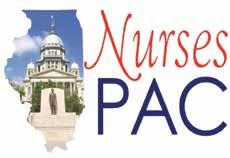
Nurses want to provide quality care for their patients.
The Nurses Political Action Committee (Nurses- PAC) makes sure Springfield gives them the resources to do that.
Help the Nurses-PAC, help YOU!
So. . . . . . . if you think nurses need more visibility if you think nurses united can speak more effectively in the political arena if you think involvement in the political process is every citizen’s responsibility.
Become a Nurses-PAC contributor TODAY!
❑ I wish to make my contribution via personal check (Make check payable to Nurses-PAC).
❑ I wish to make a monthly contribution to NursesPAC via my checking account. By signing this form, I authorize the charge of the specified amount payable to Nurses-PAC be withdrawn from my account on or after the 15th of each month. (PLEASE INCLUDE A VOIDED CHECK WITH FORM)
❑ I wish to make my monthly Nurses-PAC contribution via credit card. By signing this form, I authorize the charge of the specified contribution to Nurses-PAC on or after the 15th of each month.
❑ I wish to make my annual lump sum Nurses-PAC contribution via a credit or debit card. By signing this form, I authorize ANA-Illinois to charge the specified contribution to Nurses-PAC via a ONE TIME credit/debit card charge.
❑ Mastercard ❑ VISA
Credit card number Expires CVV
Signature:
Date:
Printed Name:
E-Mail:
Address:
City, State, Zip Code:
Preferred Phone Number:
Please mail completed form & check to: ANA-Illinois
Atten: Nurses-PAC PO Box 636 Manteno, Illinois 60950
